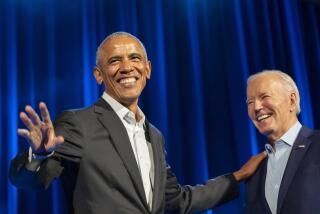Bloomberg details first round of his massive campaign spending

- Share via
WASHINGTON — Michael R. Bloomberg provided the first snapshot of his immense spending on his Democratic presidential bid on Friday, filing a federal disclosure report that showed the former New York mayor and billionaire businessman had poured $188 million into the race in just over a month.
The report to the Federal Election Commission, covering the period from Bloomberg’s declaration of candidacy in late November through the end of 2019, dwarfs what any candidate in American history has invested in the first quarter of a presidential run. He has since eclipsed even that amount, with his spending on advertising alone soaring past $300 million in January.
The heavy investment appears to be paying off, as Bloomberg quickly ascended in national polls while pursuing an unconventional and extremely costly strategy. He is skipping the states including Iowa and New Hampshire that vote first to focus on the much bigger, more numerous and delegate-rich Super Tuesday states voting March 3, including California. The diffuse strategy requires a campaign organization and ad spending unprecedented at this stage in a primary election season.
“Our first month’s filing represents a down payment and commitment in all 50 states to defeat Donald Trump, and it shows we have the resources and plan necessary to take him on,” said campaign manager Kevin Sheekey.
As Bloomberg’s relentless spending rattles the presidential race, the Democratic National Committee moved Friday to nudge him onto the national debate stage.
Bloomberg has not participated in any of the televised debates because he did not do any fundraising, making it impossible for him to amass the number of people donating to a campaign required to qualify under party rules. Bloomberg doesn’t have a single donor other than himself.
The committee has now scrapped the donor requirements. Bloomberg’s recent polling numbers put him on track to reach 10% in four national polls before the mid-February debate in Nevada, a threshold that would qualify him under the new rules.
The DNC’s shift riled some competing campaigns. Jeff Weaver, a senior advisor to Vermont Sen. Bernie Sanders, accused the party of changing the rules to accommodate Bloomberg, calling it “the definition of a rigged system.” Candidates that had struggled to meet the donor thresholds also chafed.
Yet some progressive activists — including in Sanders’ camp — had been demanding a change that would force Bloomberg onto the debate stage to be tested. They complained that his personal fortune enabled him to sidestep the scrutiny of the televised questioning in debates while buying his support in the polls.
Bloomberg’s initial $188 million was mostly for television advertising. The latest data from Advertising Analytics, which tracks advertising buys, shows Bloomberg has surpassed the $300-million mark just in the new year’s first month.
The campaign’s payroll has also exploded. For the reporting period, Bloomberg’s operation had a staff of about 150. The payroll has now grown to 1,000 in 35 states, according to the campaign.
His money also flowed to equip the data-centric campaign with various technological tools to place online content for the candidate. Bloomberg, who made his fortune with a high-tech, global news-gathering operation, put $12 million toward a start-up created to erase a digital advantage that he believes Republicans hold nationwide.
The campaign also spent $679,000 on furnished temporary housing for its army of employees, as Bloomberg scrambled to draw talent to his New York City headquarters after entering the race late.
The only other candidate whose spending comes near rivaling Bloomberg’s is also a billionaire, Californian Tom Steyer. Steyer has spent at least $140 million on television since entering the race over the summer.
In all of 2019, all other Democrats in the race did not spend even half of what the Bloomberg campaign did in the year’s final weeks. That includes Sanders, who has drawn well over 1 million donors to his campaign.
Sanders raised $34.5 million in the last quarter, an impressive show of force for a candidate relying entirely on small donors. Yet he used all that and more, $50 million, in the sprint before voting begins Monday with the caucuses in Iowa. His campaign still ended the year very much in the black, with more than $18 million in the bank.
While Bloomberg’s immense spending irks his rivals, it could ultimately prove a boon to at least one of them. The candidate has hired his staff through November, vowing to put them to work defeating President Trump, whether Bloomberg is the nominee or not. He has said he is prepared to spend $1 billion on that effort.
The cash infusion comes as a counterweight to the huge war chest Trump has been accumulating, as well as to the potent digital persuasion effort the president’s campaign has unleashed.
A campaign cycle that began with Trump’s online messaging dominating that of Democrats is now shaping up to be more competitive with Bloomberg in the race. As of last week, Bloomberg had outspent the Trump campaign on Facebook and Google, with expenditures of $45 million, according to ACRONYM, a group that advises progressives on digital strategy.
More to Read
Get the L.A. Times Politics newsletter
Deeply reported insights into legislation, politics and policy from Sacramento, Washington and beyond. In your inbox twice per week.
You may occasionally receive promotional content from the Los Angeles Times.










